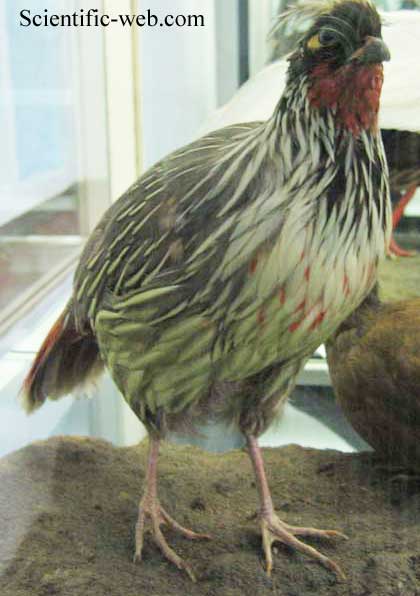
Ithaginis cruentus , Photo: Michael Lahanas
Subregnum: Eumetazoa
Cladus: Bilateria
Cladus: Nephrozoa
Superphylum: Deuterostomia
Phylum: Chordata
Cladus: Craniata
Subphylum: Vertebrata
Infraphylum: Gnathostomata
Superclassis: Tetrapoda
Cladus: Reptiliomorpha
Cladus: Amniota
Classis: Reptilia
Cladus: Eureptilia
Cladus: Romeriida
Subclassis: Diapsida
Cladus: Sauria
Infraclassis: Archosauromorpha
Cladus: Crurotarsi
Divisio: Archosauria
Subsectio: Ornithodira
Subtaxon: Dinosauromorpha
Cladus: Dinosauria
Ordo: Saurischia
Cladus: Theropoda
Cladus: Neotheropoda
Infraclassis: Aves
Cladus: Euavialae
Cladus: Avebrevicauda
Cladus: Pygostylia
Cladus: Ornithothoraces
Cladus: Euornithes
Cladus: Ornithuromorpha
Cladus: Ornithurae
Cladus: Carinatae
Parvclassis: Neornithes
Cohors: Neognathae
Cladus: Galloanseres
Ordo: Galliformes
Familia: Phasianidae
Subfamilia: Phasianinae
Genus: Ithaginis
Species: Ithaginis cruentus
Subspecies: I. c. affinis – I. c. beicki – I. c. berezowskii – I. c. clarkei – I. c. cruentus – I. c. geoffroyi – I. c. kuseri – I. c. marionae – I. c. michaelis – I. c. rocki – I. c. sinensis – I. c. tibetanus
Name
Ithaginis cruentus (Hardwicke, 1821)
Synonymy
Phasianus cruentus (protonym)
References
Transactions of the Linnean Society of London 13: 237.
Vernacular names
العربية: تدرج الدم
български: Кървав фазан
català: Faisà sagnant
čeština: Bažant krvavý
Cymraeg: Ffesant waed
Deutsch: Blutfasan
English: Blood Pheasant
Esperanto: Sanga fazano
español: Faisán ensangrentado
eesti: Püüfaasan
français: Ithagine ensanglantée
עברית: פסיון הדם
हिन्दी: चिल्मिआ
magyar: Vérfácán
Bahasa Indonesia: Pegar darah
italiano: Fagiano insanguinato
日本語: ベニキジ
മലയാളം: ബ്ലഡ് ഫെസന്റ്
မြန်မာဘာသာ: ရစ်နီ
नेपाली: चिलिमे
Nederlands: Bloedfazant
polski: Kuropatnik
پنجابی: رت فیزنٹ
русский: Итагин
svenska: Blodfasan
ไทย: ไก่ฟ้าสีเลือด
українська: Багряний фазан
中文: 血雉

Ithaginis cruentus
The blood pheasant (Ithaginis cruentus), also known as blood partridge, is the only species in genus Ithaginis and tribe Ithaginini of the pheasant family. It is a relatively small, short-tailed pheasant that is widespread and is fairly common in eastern Himalayas, ranging across India, Nepal, Bhutan, China, and northern Myanmar. Since the trend of the population appears to be slowly decreasing, the species has been evaluated as of least concern by IUCN in 2009.[1]
The blood pheasant was the national bird of the former Kingdom of Sikkim,[2] and remains Sikkim's state bird.[3]
Description
A female from Sikkim, India
The blood pheasant has the size of a small fowl, about 17 in (43 cm) in length with a short, convex, very strong black bill, feathered between bill and eye, and a small crest of variously coloured feathers. The colour of the plumage above is dark ash, with white shafts, the coverts of the wings various tinged with green, with broad strokes of white through the length of each feather, the feathers of the chin deep crimson; on the breast, belly, and sides, feathers are lance-shaped, of various length, the tips green with crimson margins, collectively resembling dashes of blood scattered on the breast and belly. The tail consists of 12 subequal feathers, shafts white, rounded, the ends whitish, the coverts a rich crimson red.[4]
Both males and females have red feet and a distinct ring of bare skin around the eye that typically is crimson colored, but is orange in a few subspecies. Females are more uniformly colored, being overall dull brown and often with some gray to the nape. Although some of the subspecies that have been described are highly distinctive, others are not, and some variation appears to be clinal. Consequently, the number of valid subspecies is disputed, with various authorities recognizing between 11 and 15. They mainly vary in the plumage of the males, especially the amount of red or black to the throat, forehead, neck, chest and tail, and the presence or absence of rufous in the wings.[5]
Taxonomy
Twelve subspecies are recognized:
I. c. affinis (CW Beebe, 1912) – Sikkim region in India
I. c. beicki (Mayr and Birckhead, 1937) – Beick's blood pheasant – north-central China
I. c. berezowskii (Bianchi, 1903) – Berezovski's blood pheasant – mountains of central China
I. c. clarkei (Rothschild, 1920) – Clarke's blood pheasant – southwest China
I. c. cruentus (Hardwicke, 1821) – Himalayan blood pheasant – northern Nepal to northwestern Bhutan
I. c. geoffroyi (Verreaux, 1867) – Geoffroy's blood pheasant – western China and southeast Tibet
I. c. kuseri (Beebe, 1912) – Kuser's blood pheasant – upper Assam in India and southeast Tibet
I. c. marionae (Mayr, 1941) – Mrs. Vernay's blood pheasant' – mountains of southwest China and northeast Myanmar
I. c. michaelis (Bianchi, 1903) – Bianchi's blood pheas-ant – north-central China
I. c. rocki (Riley, 1925) – Rock's blood pheasant – southwestern China
I. c. sinensis (David, 1873) – David's blood pheasant – central China
I. c. tibetanus (Baker, 1914) – Tibetan blood pheasant – eastern Bhutan and southern Tibet
Distribution and habitat
Blood pheasants live in the mountains of Nepal, Sikkim, northern Myanmar, Tibet, and central and south-central China, where they prefer coniferous or mixed forests and scrub areas near the snowline. They move their range depending on the seasons, and are found at higher elevations during the summer. With snow increasing in fall and winter, they move to lower elevations.[5]
Ecology
Unlike the common pheasant, the blood pheasant is monogamous.[6] Breeding season begins at the end of April when males begin their courtship by displaying in front of females by flying at each other breast-to-breast, biting wattles, or performing high leaps with kicks toward the other’s bill.[7] Mate choice by females depends on factors like tail length, length of the ear tufts, and the presence of black points in the wattle, but neither wattle size or color nor the brightness of the plumage affect the females' choice.[8]
The blood pheasant reaches sexual maturity in one year.[7] In early May, mature females begin nesting under paddy straw heaps surrounded by trees, in brush, small caves, or in tree holes near the ground.[9] They excavate shallow pot-like nests and line them with moss, pine needles, and feathers. The female lays 4-14 yellowish-white eggs with brown speckles, at intervals of two or three days. During the 27-33 days of egg incubation, the male is responsible for defending the territory against other male pheasants.[9]
The blood pheasant's distribution in inhospitable high‐elevation environments has required adaptation to hypoxia and high levels of ultraviolet radiation.[6]
Blood pheasants move with the snow line when foraging, feeding on moss, ferns, pine shoots, and lichens.
Conservation
The species is currently classified as Least Concern by the IUCN.[1] However, more than half the population is considered under threats due to habitat loss and fragmentation, illegal harvest, and human disturbance.[10] Much of the distribution range of pheasants in Southwest China overlaps with the habitat of the giant panda, and livestock grazing has become the most prevalent human disturbance across associated protection areas.[11] The blood pheasant's ground-nesting habits and relatively long incubation period make it especially vulnerable to trampling and habitat degradation by grazers.[10][12]
References
BirdLife International (2016). "Ithaginis cruentus". IUCN Red List of Threatened Species. 2016: e.T22679144A92804363. doi:10.2305/IUCN.UK.2016-3.RLTS.T22679144A92804363.en. Retrieved 19 November 2021.
Verma, R. (1999). Sikkim: A Guide and Handbook : with Road, Town, and Trekking Maps. Gangtok, India: S. Verma. p. 130. ASIN B0006FEJ74.
Kazmierczak, K.; Singh, R. (1998). A Birdwatchers' Guide to India. London, UK: Prion. p. 137. ISBN 978-1-871104-08-0.
Hardwicke, T. (1821). "Descriptions of a Wild Dog of Sumatra, a new Species of Viverra, and a new Species of Pheasant". The Transactions of the Linnean Society of London. Linnean Society of London. XIII: 235–238.
Johnsgard, P. A. (1999) The Pheasants of the World: Biology and Natural History. Washington, D.C: Smithsonian Institution Press
Zhou, C.; Liu, Y.; Qiao, L.; Liu, Y.; Yang, N.; Meng, Y. & Yue, B. (2020). "The draft genome of the blood pheasant (Ithaginis cruentus): Phylogeny and high-altitude adaptation". Ecology and Evolution. 10 (20): 11440–11452. doi:10.1002/ece3.6782.
Switzer, C. "Phasianus colchicus (common pheasant)". Animal Diversity Web.
Mateos, C. & Carranza, J. (1995). "Female choice for morphological features of male ring-necked pheasants". Animal Behaviour. 49 (3): 737–748. doi:10.1016/0003-3472(95)80206-1.
"Blood Pheasants | Beauty of Birds". www.beautyofbirds.com.
Fan, F.; Bu, H.; McShea, W.J.; Shen, X.; Li, B.V. & Li, S. (2020). "Seasonal habitat use and activity patterns of blood pheasant Ithaginis cruentusbe in the presence of free-ranging livestock". Global Ecology and Conservation. 23: e01155. doi:10.1016/j.gecco.2020.e01155.
Wei, W.; Swaisgood, R. R.; Dai, Q.; Yang, Z.; Yuan, S.; Owen, M. A.; Pilfold, N. W.; Yang, X.; Gu, X.; Zhou, H.; Han, H.; Zhang, J.; Hong, M.; Zhang, Z. (2018). "Giant panda distributional and habitat-use shifts in a changing landscape". Conservation Letters. 11 (6): e12575. doi:10.1111/conl.12575.
Jia, C.-X.; Sun, Y.-H.; Swenson, J. E. (2010). "Unusual Incubation Behavior and Embryonic Tolerance of Hypothermia by the Blood Pheasant (Ithaginis cruentus)". The Auk. 127 (4): 926–931. doi:10.1525/auk.2010.09254.
Retrieved from "http://en.wikipedia.org/"
All text is available under the terms of the GNU Free Documentation License

